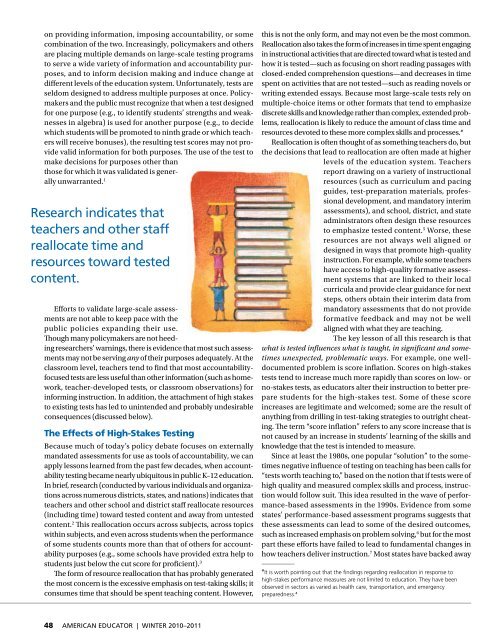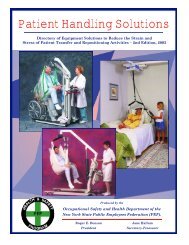American Educator, Winter 2010-11, Vol. 34, No. 4, AFT
American Educator, Winter 2010-11, Vol. 34, No. 4, AFT
American Educator, Winter 2010-11, Vol. 34, No. 4, AFT
Create successful ePaper yourself
Turn your PDF publications into a flip-book with our unique Google optimized e-Paper software.
on providing information, imposing accountability, or some<br />
combination of the two. Increasingly, policymakers and others<br />
are placing multiple demands on large-scale testing programs<br />
to serve a wide variety of information and accountability purposes,<br />
and to inform decision making and induce change at<br />
different levels of the education system. Unfortunately, tests are<br />
seldom designed to address multiple purposes at once. Policymakers<br />
and the public must recognize that when a test designed<br />
for one purpose (e.g., to identify students’ strengths and weaknesses<br />
in algebra) is used for another purpose (e.g., to decide<br />
which students will be promoted to ninth grade or which teachers<br />
will receive bonuses), the resulting test scores may not provide<br />
valid information for both purposes. The use of the test to<br />
make decisions for purposes other than<br />
those for which it was validated is generally<br />
unwarranted. 1<br />
Research indicates that<br />
teachers and other staff<br />
reallocate time and<br />
resources toward tested<br />
content.<br />
Efforts to validate large-scale assessments<br />
are not able to keep pace with the<br />
public policies expanding their use.<br />
Though many policymakers are not heeding<br />
researchers’ warnings, there is evidence that most such assessments<br />
may not be serving any of their purposes adequately. At the<br />
classroom level, teachers tend to find that most accountabilityfocused<br />
tests are less useful than other information (such as homework,<br />
teacher-developed tests, or classroom observations) for<br />
informing instruction. In addition, the attachment of high stakes<br />
to existing tests has led to unintended and probably undesirable<br />
consequences (discussed below).<br />
The Effects of High-Stakes Testing<br />
Because much of today’s policy debate focuses on externally<br />
mandated assessments for use as tools of accountability, we can<br />
apply lessons learned from the past few decades, when accountability<br />
testing became nearly ubiquitous in public K–12 education.<br />
In brief, research (conducted by various individuals and organizations<br />
across numerous districts, states, and nations) indicates that<br />
teachers and other school and district staff reallocate resources<br />
(including time) toward tested content and away from untested<br />
content. 2 This reallocation occurs across subjects, across topics<br />
within subjects, and even across students when the performance<br />
of some students counts more than that of others for accountability<br />
purposes (e.g., some schools have provided extra help to<br />
students just below the cut score for proficient). 3<br />
The form of resource reallocation that has probably generated<br />
the most concern is the excessive emphasis on test-taking skills; it<br />
consumes time that should be spent teaching content. However,<br />
48 AMERICAN EDUCATOR | WINTER <strong>2010</strong>–20<strong>11</strong><br />
this is not the only form, and may not even be the most common.<br />
Reallocation also takes the form of increases in time spent engaging<br />
in instructional activities that are directed toward what is tested and<br />
how it is tested—such as focusing on short reading passages with<br />
closed-ended comprehension questions—and decreases in time<br />
spent on activities that are not tested—such as reading novels or<br />
writing extended essays. Because most large-scale tests rely on<br />
multiple-choice items or other formats that tend to emphasize<br />
discrete skills and knowledge rather than complex, extended problems,<br />
reallocation is likely to reduce the amount of class time and<br />
resources devoted to these more complex skills and processes.*<br />
Reallocation is often thought of as something teachers do, but<br />
the decisions that lead to reallocation are often made at higher<br />
levels of the education system. Teachers<br />
report drawing on a variety of instructional<br />
resources (such as curriculum and pacing<br />
guides, test-preparation materials, professional<br />
development, and mandatory interim<br />
assessments), and school, district, and state<br />
administrators often design these resources<br />
to emphasize tested content. 5 Worse, these<br />
resources are not always well aligned or<br />
designed in ways that promote high-quality<br />
instruction. For example, while some teachers<br />
have access to high-quality formative assessment<br />
systems that are linked to their local<br />
curricula and provide clear guidance for next<br />
steps, others obtain their interim data from<br />
mandatory assessments that do not provide<br />
formative feedback and may not be well<br />
aligned with what they are teaching.<br />
The key lesson of all this research is that<br />
what is tested influences what is taught, in significant and sometimes<br />
unexpected, problematic ways. For example, one welldocumented<br />
problem is score inflation. Scores on high-stakes<br />
tests tend to increase much more rapidly than scores on low- or<br />
no-stakes tests, as educators alter their instruction to better prepare<br />
students for the high-stakes test. Some of these score<br />
increases are legitimate and welcomed; some are the result of<br />
anything from drilling in test-taking strategies to outright cheating.<br />
The term “score inflation” refers to any score increase that is<br />
not caused by an increase in students’ learning of the skills and<br />
knowledge that the test is intended to measure.<br />
Since at least the 1980s, one popular “solution” to the sometimes<br />
negative influence of testing on teaching has been calls for<br />
“tests worth teaching to,” based on the notion that if tests were of<br />
high quality and measured complex skills and process, instruction<br />
would follow suit. This idea resulted in the wave of performance-based<br />
assessments in the 1990s. Evidence from some<br />
states’ performance-based assessment programs suggests that<br />
these assessments can lead to some of the desired outcomes,<br />
such as increased emphasis on problem solving, 6 but for the most<br />
part these efforts have failed to lead to fundamental changes in<br />
how teachers deliver instruction. 7 Most states have backed away<br />
*It is worth pointing out that the findings regarding reallocation in response to<br />
high-stakes performance measures are not limited to education. They have been<br />
observed in sectors as varied as health care, transportation, and emergency<br />
preparedness. 4





